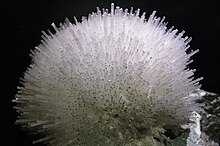| Mesolite | |
|---|---|
 Mesolite from Bombay collected in the 18th century by Dr John Hunter | |
| General | |
| Category | Tectosilicate Zeolite |
| Formula (repeating unit) | Na2Ca2(Al2Si3O10)3·8H2O |
| IMA symbol | Mes[1] |
| Strunz classification | 9.GA.05 |
| Crystal system | Orthorhombic |
| Crystal class | Pyramidal (mm2) (same H-M symbol) |
| Space group | Fdd2 |
| Unit cell | a = 18.4049(8) Å, b = 56.655(6) Å, c = 6.5443(4) Å; Z = 8 |
| Identification | |
| Color | Colorless, white, gray, yellowish brown |
| Crystal habit | As elongated prismatic crystals, commonly in hairlike tufts and aggregates of fibers; radiating compact masses; stalactitic; porcelaneous |
| Twinning | Characteristically twinned on {010} or {100} |
| Cleavage | Perfect on {110} and {110} |
| Fracture | Uneven |
| Tenacity | Brittle, masses tough |
| Mohs scale hardness | 5 |
| Luster | Vitreous, silky when fibrous |
| Streak | White |
| Diaphaneity | Transparent to translucent, opaque |
| Specific gravity | 2.26 |
| Optical properties | Biaxial (+) |
| Refractive index | nα = 1.505 nβ = 1.505 nγ = 1.505 |
| Birefringence | δ = 0.001 |
| 2V angle | Measured: 80° |
| Other characteristics | May exhibit a small pyroelectric effect; piezoelectric |
| References | [2][3][4][5] |
Mesolite is a tectosilicate mineral with formula Na2Ca2(Al2Si3O10)3·8H2O. It is a member of the zeolite group and is closely related to natrolite which it also resembles in appearance.
Mesolite crystallizes in the orthorhombic system and typically forms fibrous, acicular prismatic crystals or masses.[3] Radiating sprays of needlelike crystals are not uncommon. It is vitreous in luster and clear to white in color. It has a Mohs hardness of 5 to 5.5 and a low specific gravity of 2.2 to 2.4. The refractive indices are nα=1.505 nβ=1.505 nγ=1.506.
- ^ Warr, L.N. (2021). "IMA–CNMNC approved mineral symbols". Mineralogical Magazine. 85 (3): 291–320. Bibcode:2021MinM...85..291W. doi:10.1180/mgm.2021.43. S2CID 235729616.
- ^ Mineralienatlas
- ^ a b Handbook of Mineralogy
- ^ Mindat.org
- ^ Webmineral data